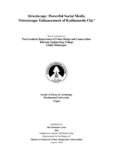Please use this identifier to cite or link to this item:
https://elibrary.khec.edu.np/handle/123456789/468| Title: | Streetscape: Powerful Social Media ‘Streetscape Enhancement of Kathmandu City’ |
| Authors: | Min Bahadur Lama |
| Issue Date: | 2020 |
| College Name: | Khwopa Engineering College Khwopa Engineering College |
| Level: | Masters |
| Degree: | MSc in Urban Design and Conservation |
| Abstract: | Street is the first public place, people experience while coming out from enclosed building space to external built environment. Street is also the media where people interact about their opinion, feelings and response to others. People are free to meet, walk, ride, sit and watch others activity as part of social interaction. It acts as a medium for movement from one point to other point of the city. People observe the city while moving through it and the other environmental elements arranged and related with it. Streetscape is a term used to describe the natural and built fabric of the street, and defined as the design quality of the street and its visual effect. It defines the interrelation of the street and the built fabric with the comprehensive involvement of people for safe, healthy and ecofriendly built environment. Streets of the modern city are mainly conceived and designed to accommodate vehicles. Given that the streets are separated from the buildings, life inside buildings is separated from life on the streets. Previously, streets were primarily intended for pedestrian movement and different social activities. The streets were even used to carry out different daily household activities. However, after modernization and advancement in technology, people are more concerned on vehicular movement and modern technology for the interaction among the people which has seriously affected on their social life. People are being paralyzed more and more by which only standard of living has increased but not the quality life. Kathmandu city, with the advancement on technology and rapid urbanization as like other cities in the world, has been central and focal hub for the social, commercial, industrial and recreational activities. People from whole Nepal migrate here in Kathmandu in search for better and quality of life. So, with the increase in the population, there is increase in movement and circulation of people form one corner to the other corner of the city. Centralized infrastructural development activities has further tightened the people of the city within the city circumference. Fast changing and competitive development activities has resulted in more pressure for fast, easy and comfortable transportation movement inside city. In order to accommodate the pressure, government has extended and widened road network for proper circulation of people. However, due to lack of proper and sustainable transportation management, high level of traffic are found in different area of the city which has further decreases the need of fast and easy movement. Many of the pedestrian walkway are demolished in the name of widening of the road which has encouraged private vehicle users rather than public vehicle users. Kathmandu City, which once was more social pedestrian friendly road network, with the enactment of vehicularisation of road, has degraded the social dimension of the pedestrianized street. This has resulted in haphazard transportation development due to priority much given to vehicle rather than pedestrian movement. Today, street of Kathmandu are more vehicle oriented rather than pedestrian which has destroyed the social character of the street and overall visual quality of the streetscape. Somewhere, there are wide pedestrian walkway but carries low pedestrian flow and somewhere there are narrow pedestrian walkway but carries more pedestrian flow. There is more imbalance and lack of pedestrian movement in the street. Lifeless vehicle are dominating more on the people and their social pedestrian aspects. Here, the research has tries to study on the cause for the degradation of the social pedestrian character of the street of Kathmandu in Putalisadak lane, Singha Durbar lane and Durbar Marg lane. Through the detail study of the selected site regarding pedestrian flow, vehicular flow, existing adjacent building use and issues, it emphasizes on how the social character of the street can be achieved through proper pedestrian network incorporating the need of vehicular movement. Conclusion are withdrawn and finally selected site specific guidelines are formulated with the streetscape design of those streets. |
| URI: | https://elibrary.khec.edu.np/handle/123456789/468 |
| Appears in Collections: | Master of Science (M.Sc) in Urban Design and Conservation |
Files in This Item:
| File | Description | Size | Format | |
|---|---|---|---|---|
| MIN BAHADUR LAMA.pdf Restricted Access | 12.06 MB | Adobe PDF |  View/Open Request a copy |
Items in DSpace are protected by copyright, with all rights reserved, unless otherwise indicated.
